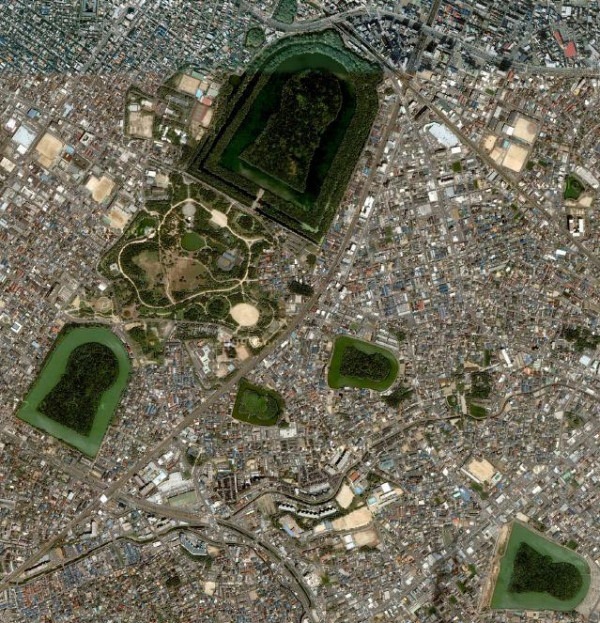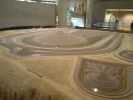It looks like you're using an Ad Blocker.
Please white-list or disable AboveTopSecret.com in your ad-blocking tool.
Thank you.
Some features of ATS will be disabled while you continue to use an ad-blocker.
24
share:

Kofun (古墳, from Sino-Japanese "ancient grave") are megalithic tombs or tumuli in Japan, constructed between the early 3rd century and the early 7th century AD. The term Kofun is the origin of the name of the Kofun period, which indicates the middle 3rd century to early-middle 6th century. Many Kofun have distinctive keyhole-shaped mounds (zenpo-koenfun (前方後円墳?)), which are unique to ancient Japan. The Mozu-Furuichi kofungun or tumulus clusters have been proposed for inscription on the UNESCO World Heritage List, while Ishibutai Kofun is one of a number in Asuka-Fujiwara similarly residing on the Tentative List.
Today I thought I'd share with you one of what I think rather unique sites in Japan. What makes this particular site interesting isn't just it's rather cool and slightly futuristic design but in addition, Is it's over all size and complexity. It's not 'As Ancient' as most of what I've posted over the years here at ATS but, its still pretty darn cool nonetheless.
To get a sense of the original grandeur I'll first post the following images. The first one shows us how it appears in our modern era. Not much detail though, It's pretty over grown, Not only that but the city has pretty much consumed much of the area just outside of the tombs.

Daisen Kofun, the largest of all kofun, one of many tumuli in the Mozu kofungun, Sakai, Osaka Prefecture (5th century)
For a better perspective of it's original magnificence click the thumbnail. You'll notice towards the bottom left side a scaled representation of a funeral procession.


The kofun tumuli have assumed various shapes throughout history. The most common type of kofun is known as a zempō-kōen-fun (前方後円墳?), which is shaped like a keyhole, having one square end and one circular end, when viewed from above. There are also circular-type (empun (円墳?)), "two conjoined rectangles" typed (zempō-kōhō-fun (前方後方墳?)), and square-type (hōfun (方墳?)) kofun. Orientation of kofun is not specified. For example, in the Saki Kofun group, all of the circular parts are facing north, but there is no such formation in the Yanagimoto kofun group. Haniwa, terracotta figures, were arrayed above and in the surroundings to delimit and protect the sacred areas.
Kofun range from several metres to over 400m long. The largest, which has been attributed to Emperor Nintoku, is Daisen kofun in Sakai City, Osaka Prefecture.
The funeral chamber was located beneath the round part and comprised a group of megaliths. In 1972, the unlooted Takamatsuzuka Tomb was found in Asuka, and some details of the discovery were revealed. Inside the tightly assembled rocks, white lime plasters were pasted, and colored pictures depict the 'Asuka Beauties' of the court as well as constellations. A stone coffin was placed in the chamber, and accessories, swords, and bronze mirrors were laid both inside and outside the coffin. The wall paintings have been designated national treasures and the grave goods as important cultural property, while the tumulus is a special historic site
thanks slayer, great as usual. I have seen these and they are really something, reminds me of other sites around the world. seems to be a trend going
back thousands of years, stone encasements of the leaders inside grand structures, the ancients were more in touch with each other than we are led to
believe, our real history is clouded with pure BS...
Beautiful things- and something I hadn't encountered yet. Thanks for a fascinating summary!
Looks like a bunch of "star-trek" era star-ships docked / landed.
Makes you wonder if past civilizations built mock up temples, or monuments of what they saw. Like those south pacific island tribes during world war 2 that never saw planes before. They were found later building wood monuments of planes they saw flying over them. In hopes they'd return and bring more food!
Cool post, thanks!
Makes you wonder if past civilizations built mock up temples, or monuments of what they saw. Like those south pacific island tribes during world war 2 that never saw planes before. They were found later building wood monuments of planes they saw flying over them. In hopes they'd return and bring more food!
Cool post, thanks!
originally posted by: Triton1128
Makes you wonder if past civilizations built mock up temples, or monuments of what they saw. Like those south pacific island tribes during world war 2 that never saw planes before. They were found later building wood monuments of planes they saw flying over them. In hopes they'd return and bring more food!
Cool post, thanks!
OK, so if they never saw planes before, how'd they make an association with food ??
en.wikipedia.org...
I think you should actually look at some ancient Temples, they don't look like spaceships at all, you seem to be reacting with unqualified assumption..

oh except one of them looks like a UFO, or a circle, only you can decide
a reply to: Marduk
My post was partially in jest.
The post about the south pacific islanders was just an additional fun bit of info. The US, was dropping supply crates containing food and supply's. Some of those tribes got a hold of the contents, and assumed " the gods " were showering them with gifts.
So, they started building replica's of these sky "gods", in hopes they would drop more food, ect..
My post was partially in jest.
The post about the south pacific islanders was just an additional fun bit of info. The US, was dropping supply crates containing food and supply's. Some of those tribes got a hold of the contents, and assumed " the gods " were showering them with gifts.
So, they started building replica's of these sky "gods", in hopes they would drop more food, ect..
edit on 4-9-2016 by Triton1128 because: (no reason given)
new topics
-
Benny Gantz Issues Ultimatum to Netanyahu with Threat to Resign
Middle East Issues: 1 hours ago -
British-Israeli Historian Detained and Interrogated by the FBI for having the 'wrong' views
Other Current Events: 4 hours ago -
A duel between two cats and crows as seconds
ATS Skunk Works: 6 hours ago -
James O keefe from Veritas controlled opposition.
Medical Issues & Conspiracies: 11 hours ago -
Political Commentator Alice Stewart Supposedly Died of Natural Causes on a Sidewalk Last Night.
General Conspiracies: 11 hours ago -
BIG REVEAL | Intelligence advisor says ‘catastrophic disclosure’ about UFOs may be on horizon
Aliens and UFOs: 11 hours ago
top topics
-
Madness will ensue here. Be ready.
General Chit Chat: 12 hours ago, 8 flags -
BIG REVEAL | Intelligence advisor says ‘catastrophic disclosure’ about UFOs may be on horizon
Aliens and UFOs: 11 hours ago, 8 flags -
Political Commentator Alice Stewart Supposedly Died of Natural Causes on a Sidewalk Last Night.
General Conspiracies: 11 hours ago, 6 flags -
A duel between two cats and crows as seconds
ATS Skunk Works: 6 hours ago, 6 flags -
FO!!! FO!! FO!!...dammit!!
Food and Cooking: 12 hours ago, 4 flags -
British-Israeli Historian Detained and Interrogated by the FBI for having the 'wrong' views
Other Current Events: 4 hours ago, 3 flags -
James O keefe from Veritas controlled opposition.
Medical Issues & Conspiracies: 11 hours ago, 2 flags -
Would you give part of your liver to someone who needed it but could not stop drinking?
General Chit Chat: 15 hours ago, 2 flags -
The Rift
Fantasy & Science Fiction: 15 hours ago, 2 flags -
Benny Gantz Issues Ultimatum to Netanyahu with Threat to Resign
Middle East Issues: 1 hours ago, 1 flags
active topics
-
A duel between two cats and crows as seconds
ATS Skunk Works • 13 • : Xtrozero -
WATCH 1740 Russian Soldiers Destroyed By Ukrainian Forces While Advancing In Kharkiv
World War Three • 193 • : Xtrozero -
Madness will ensue here. Be ready.
General Chit Chat • 25 • : Draculad -
Gaza Genocide Real or Propaganda
Middle East Issues • 624 • : DBCowboy -
Would you give part of your liver to someone who needed it but could not stop drinking?
General Chit Chat • 7 • : alwaysbeenhere2 -
Scientists assaulted at Skinwalker Ranch (Bigelow era)
Aliens and UFOs • 27 • : BeTheGoddess2 -
US 'Uniparty' officially throws Christians to the lions...
Conspiracies in Religions • 32 • : grey580 -
BIG REVEAL | Intelligence advisor says ‘catastrophic disclosure’ about UFOs may be on horizon
Aliens and UFOs • 30 • : Ophiuchus1 -
Goodbye ATS.
General Chit Chat • 73 • : Flyingclaydisk -
Benny Gantz Issues Ultimatum to Netanyahu with Threat to Resign
Middle East Issues • 2 • : gortex
24
